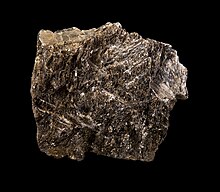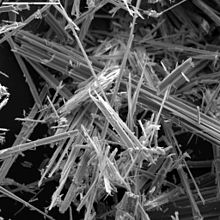Anthophyllite
| Anthophyllite | |
|---|---|
| Yellowish-white, radial-ray fibrous anthophyllite on greenish-brown vermiculite from Paakkila, Tuusniemi , Eastern Finland (field of view 4 cm) | |
| General and classification | |
| other names |
Antophyllite |
| chemical formula | (Mg, Fe 2+ ) 7 [OH | Si 4 O 11 ] 2 |
|
Mineral class (and possibly department) |
Silicates and germanates - chain and band silicates |
|
System no. to Strunz and to Dana |
9.DE.05 ( 8th edition : VIII / D.06) 66.01.02.02 |
| Crystallographic Data | |
| Crystal system | orthorhombic |
| Crystal class ; symbol | orthorhombic-dipyramidal; 2 / m 2 / m 2 / m |
| Space group | Pnma (No. 62) |
| Lattice parameters | a = 18.56 Å ; b = 18.01 Å; c = 5.28 Å |
| Formula units | Z = 4 |
| Physical Properties | |
| Mohs hardness | 5.5 to 6 |
| Density (g / cm 3 ) | measured: 2.9 to 3.5; calculated: 3.09 |
| Cleavage | completely after {210} |
| Break ; Tenacity | uneven to scalloped |
| colour | white, gray, light brown, yellow, light green |
| Line color | White |
| transparency | transparent to translucent |
| shine | Glass luster, pearlescent luster on cleavage surfaces |
| Crystal optics | |
| Refractive indices |
n α = 1.598 to 1.674 n β = 1.605 to 1.685 n γ = 1.615 to 1.697 |
| Birefringence | δ = 0.017 to 0.023 |
| Optical character | biaxial positive |
| Axis angle | 2V = measured: 57 to 90 °; calculated: 82 to 90 ° |
The mineral anthophyllite (formerly antophyllite ) is a frequently occurring chain silicate from the group of orthorhombic amphiboles . It crystallizes in the orthorhombic crystal system with the chemical composition (Mg, Fe 2+ ) 7 [OH | Si 4 O 11 ] 2 and develops mostly granular, fibrous and radial aggregates , but also long prismatic crystals in different colors, whereby brown is predominant. Other colors such as yellow, gray, white, green are mixed in, but also appear on their own. The crystals show a glass luster, whereas the cleavage surfaces show a pearly luster. When weathered, anthophyllite becomes matt.
Etymology and history

The fruit of the clove , also known as mother clove , whose Latin name is anthophylli , gave it its name because of its dark brown color . This name is derived from the Greek ἄνθος ánthos for "flower" and φύλλον phyllon for "leaf".
Anthophyllite was first described in 1801 by Christian Friedrich Schumacher , who was only known to be the area around Kongsberg in Norway.
classification
Already in the outdated 8th edition of the mineral classification according to Strunz the anthophyllite belonged to the class of "silicates and germanates" and there to the department of "chain silicates and band silicates (inosilicates)", where together with ferrogedrite , gedrit and holmquistite it belongs to the orthoamphiboles “Anthophyllite series” with infinite double chains of two (bands) [Si 4 O 11 ] 6− and the system no. VIII / D.06 within the amphibole family .
In the revised and updated Lapis mineral directory by Stefan Weiß, which, out of consideration for private collectors and institutional collections, is still based on this classic system of Karl Hugo Strunz , the mineral was given the system and mineral number. VIII / F.12-60 . In the "Lapis Classification" This also corresponds to the department "chain and chain silicates" where anthophyllite together with ferro-anthophyllite , Ferrogedrite, Ferroholmquistit , gedrite, Holmquistit, Natriumanthophyllit , sodium ferro-anthophyllite , sodium Ferrogedrite , Natriumgedrit , Proto -Anthophyllite , proto-ferro-anthophyllite , proto-ferro-suenoite form the group "Orthorhombic Amphibole" (status 2018).
The 9th edition of Strunz's mineral systematics , which has been in effect since 2001 and was updated by the International Mineralogical Association (IMA) until 2009, also classifies anthophyllite in the “chain and band silicates” department. However, this is further subdivided according to the type of chain formation, so that the mineral can be classified in the sub-section “Chain and band silicates with 2-periodic double chains, Si 4 O 11 ; Amphibole family, Klinoamphibole "is to find where it along with Cummingtonite (Rd), ferric Klinoferroholmquistit , Ferripedrizit , Ferro-anthophyllite, Ferrogedrite, Ferroholmquistit, Ferropedrizit , fluorine Pedrizit , gedrite, grunerite , Holmquistit, Klinoferroholmquistit , Manganocummingtonite , Manganogrunerit , Natriumanthophyllit , sodium Ferripedrizit (Rn), sodium ferric Ferropedrizit , sodium Ferrogedrite , sodium Ferropedrizit (H), sodium-ferrous anthophyllite (H), Natriumgedrit , Natriumpedrizit (H), Pedrizit (H), Permanganogrunerit ( H), proto-anthophyllite , proto-ferro-anthophyllite , protomangano-ferro-anthophyllite the "Mg, Fe, Mn- clinoamphibole , cummingtonite group" with the system no. 9.DE.05 forms.
The systematics of minerals according to Dana , which is common in the English-speaking world , assigns anthophyllite to the division of "chain silicates with double, unbranched chains, W = 2". Here it is together with Lobanovite, Protoanthophyllite, Ferro-Anthophyllite, Protoferro-Anthophyllite, Protomangano-Ferro-Anthophyllite, Sodium Anthophyllite, Sodium Ferro-Anthophyllite, Magnesio-Gedrit, Gedrit, Ferrogedrite, Sodium-Ferrogedrite, Sodium Driedrite, Magnesio-Holmquistite and Ferroholmquistit can be found in the unnamed group 66.01.02 within the subdivision of “Chain silicates: double unbranched chains, W = 2 amphibole configuration”.
Crystal structure
Anthophyllite crystallizes orthorhombically in the space group Pnma (space group no. 62) with the lattice parameters a = 18.56 Å ; b = 18.01 Å and c = 5.28 Å and 4 formula units per unit cell .
properties
In front of the soldering tube , anthophyllite turns greenish-black, loses its luster and becomes crumbly, but does not melt. The borax pearl is only slightly dissolved and turns greenish-yellow or leek green to olive green.
Modifications and varieties
An egg-shaped aggregate consisting of a phlogopite core and an anthophyllite crust from Heřmanov in the Czech Republic is known as the Hermanover Kugel .
Education and Locations
Anthophyllite is formed by contact or regional metamorphosis in gneisses , pegmatites and serpentinites . Accompanying minerals include cordierite , talc , chlorites , sillimanite , various mica , olivine , hornblende and gedrite , magnesio-cummingtonite , garnets , staurolite and plagioclases .
As a relatively frequent mineral formation, anthophyllite could be detected in many places, whereby around 700 sites have been documented so far (status: 2019). In addition to its type locality Kongsberg in Norway, well-known occurrences include the area around Bodenmais in Lower Bavaria (Germany) and the Sverdlovsk Oblast in the Russian Urals federal district. Anthophyllitasbest deposits are known from Paakkila ( Tuusniemi municipality ), Rikkavesi and Usinmäki in Finland , Hamersley in Australia and the Sall Mountains in the US states of Georgia and North Carolina .
Other sites are found in Egypt , the Antarctic , Ethiopia , Bolivia , Brazil , Burkina Faso , China , France , Greenland , India , Indonesia , Italy , Japan , Canada , Colombia , New Zealand , Austria , Poland , Romania , Russia , Sweden , Switzerland , Zimbabwe , Slovakia , Spain , South Africa , Tajikistan , Taiwan , Czech Republic , Ukraine , Hungary and the United Kingdom .
use
Anthophyllite was used under the name amphibole asbestos in the construction industry (asbestos cement).
As an asbestos mineral , anthophyllite ( CAS number 77536-67-5) is one of the dangerous substances whose production, placing on the market or use in the EU is restricted or prohibited in accordance with Annex XVII of the REACH regulation .
See also
literature
- Christian Friedrich Schumacher: Attempt to create a list of the simple minerals found in the Danish-Nordic states . Brummer, Copenhagen 1801, p. 96 ( rruff.info [PDF; 814 kB ; accessed on November 29, 2019] see also limited preview in Google Book Search).
- Friedrich Klockmann : Klockmann's textbook of mineralogy . Ed .: Paul Ramdohr , Hugo Strunz . 16th edition. Enke, Stuttgart 1978, ISBN 3-432-82986-8 , pp. 730 (first edition: 1891).
- Petr Korbel, Milan Novák: Mineral Encyclopedia (= Villager Nature ). Edition Dörfler im Nebel-Verlag, Eggolsheim 2002, ISBN 978-3-89555-076-8 , p. 238 .
Web links
- Mineral Atlas: Anthophyllite (Wiki)
- Anthophyllite search results. In: rruff.info. Database of Raman spectroscopy, X-ray diffraction and chemistry of minerals (RRUFF), accessed on November 29, 2019 .
- American-Mineralogist-Crystal-Structure-Database - Anthophyllite. In: rruff.geo.arizona.edu. Retrieved November 29, 2019 .
Individual evidence
- ↑ David Barthelmy: Anthophyllite Mineral Data. In: webmineral.com. Retrieved November 29, 2019 .
- ↑ a b c d Hugo Strunz , Ernest H. Nickel : Strunz Mineralogical Tables. Chemical-structural Mineral Classification System . 9th edition. E. Schweizerbart'sche Verlagbuchhandlung (Nägele and Obermiller), Stuttgart 2001, ISBN 3-510-65188-X , p. 625 (English).
- ↑ a b c d Anthophyllite . In: John W. Anthony, Richard A. Bideaux, Kenneth W. Bladh, Monte C. Nichols (Eds.): Handbook of Mineralogy, Mineralogical Society of America . 2001 (English, handbookofmineralogy.org [PDF; 81 kB ; accessed on November 29, 2019]).
- ↑ a b c d e Anthophyllite. In: mindat.org. Hudson Institute of Mineralogy, accessed November 29, 2019 .
- ↑ a b Christian Friedrich Schumacher: Attempt of a directory of the simple minerals found in the Danish-Nordic states . Brummer, Copenhagen 1801, p. 96 ( rruff.info [PDF; 814 kB ; accessed on November 29, 2019] see also limited preview in Google Book Search).
- ↑ Stefan Weiß: The large Lapis mineral directory. All minerals from A - Z and their properties. Status 03/2018 . 7th, completely revised and supplemented edition. Weise, Munich 2018, ISBN 978-3-921656-83-9 .
- ↑ Ernest H. Nickel, Monte C. Nichols: IMA / CNMNC List of Minerals 2009. (PDF 1816 kB) In: cnmnc.main.jp. IMA / CNMNC, January 2009, accessed November 29, 2019 .
- ↑ Localities for Anthophyllite. In: mindat.org. Hudson Institute of Mineralogy, accessed November 29, 2019 .
- ↑ Hans Jürgen Rösler : Textbook of Mineralogy . 4th revised and expanded edition. German publishing house for basic industry (VEB), Leipzig 1987, ISBN 3-342-00288-3 , p. 528 .
- ↑ Find location list for anthophyllite in the Mineralienatlas and Mindat , accessed on November 29, 2019.
- ↑ List of restricted substances - Annex XVII of the REACH regulation: Asbestos, anthophyllite. In: echa.europa.eu. European Chemicals Agency (ECHA), accessed August 11, 2020 .
- ↑ Regulation (EC) No. 1907/2006 of the European Parliament and of the Council. (PDF 1.97 MB) In: eur-lex.europa.eu. December 30, 2006, p. 401 , accessed on August 12, 2020 ( Official Journal of the European Union L 396).


